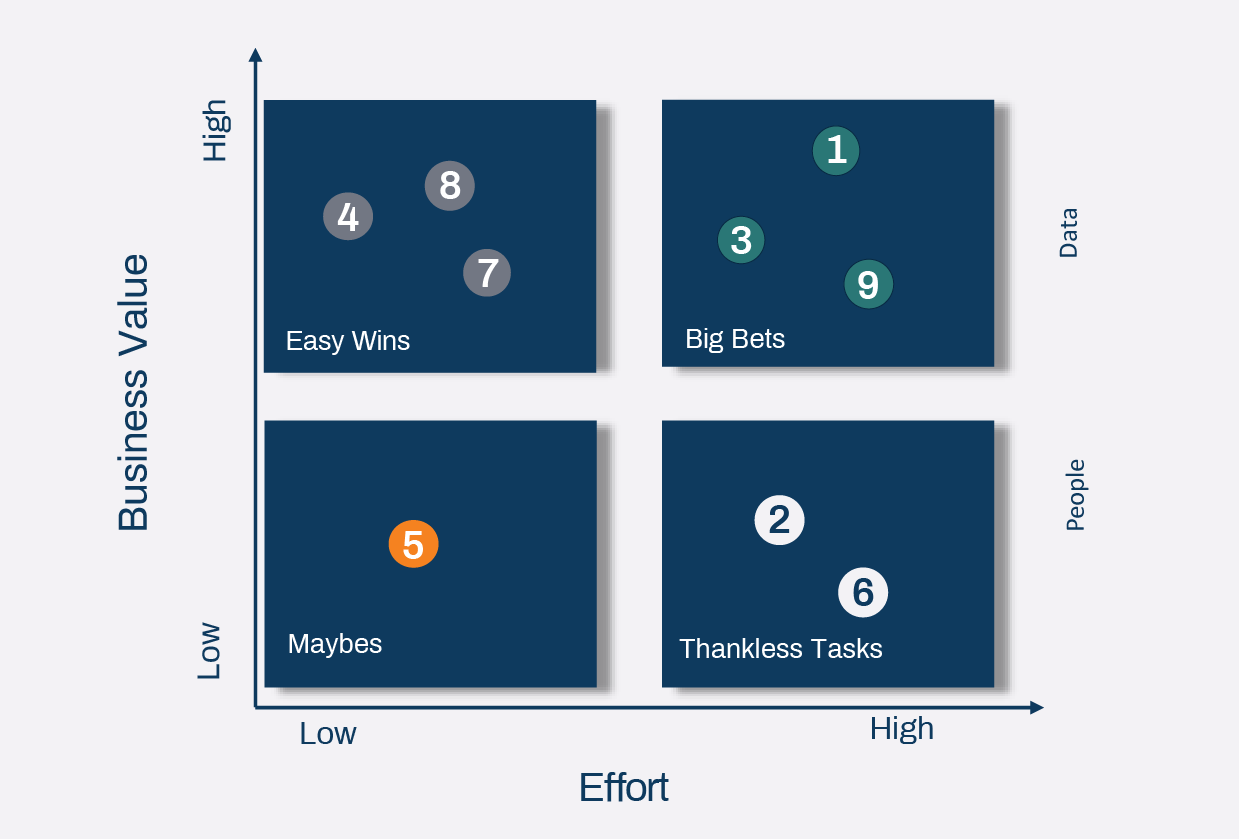If you have identified possible AI use cases for your business, the next step will be to test if they are possible to implement and if they will create great value.
While there is a lot of momentum and excitement about using AI to propel your business, the reality is only 54% of AI projects are deployed. How do you ensure you’re one of the businesses that does unlock the new opportunities AI promises?
Your success with AI begins by discovering AI use cases that work for your business. In the first blog of our Columbus AI blog series, we shared five areas where organizations should focus their efforts to generate ideas for AI implementations based on our experience.
After generating some ideas for AI use cases that could potentially benefit your company from the first step of the Columbus AI Innovation Lab, the next step is to test which AI use cases could be operationalized by evaluating them.
Columbus AI Innovation Lab
.png?width=1537&height=705&name=MicrosoftTeams-image%20(35).png)
The Discover phase: Engage key stakeholders in AI decisions
Along with the AI use cases you identified, your data science team may have other ideas from across the company. Before building an AI solution and implementation plan, you must scope and prioritize ideas creating meaningful outcomes for your business. Also important, how can you engage and get the support of the data science team?
To answer these questions and to begin the process of operationalizing AI, business and technical stakeholders must explore the ideas thoroughly, being certain that they support the business KPIs. Without that clarity, a team is far too likely to judge an AI solution’s success by the model’s performance rather than by its impact on the business. In the Columbus AI Innovation Lab framework, this four-dimension evaluation involves all stakeholders in decision-making.
1. Business: Is the AI project contributing to reaching business goals?
When evaluating an AI use case’s relevancy, business stakeholders, such as the executive team, subject matter experts, finance and more, need to determine if the use case will contribute to the organization’s desired future state. This perspective also looks for quantifiable high-level business outcomes for the use case.
In our previous example, where the goal was to increase margins by 10%, the business viewpoint would assess if implementing an AI solution would help the company achieve this goal.
2. Usage: Is the AI project viable?
Next, evaluate the tasks and activities required to realize the capabilities identified from the business viewpoint. So, even if the idea is very good and would increase margins by 10% it’s not a good use case to pursue if it doesn’t pass the usage evaluation. However, if there is a way a company can use AI to achieve the objective and the use case is deemed viable by stakeholders, then it’s a good use case.
For example, demand forecasting with AI is a method this company believes is a way to increase margins by 10% by identifying the demand and then offering a discount to push sales past the demand. However, the dealers said they couldn’t increase demand regardless of the extra discount. This use case would fail the usage evaluation. Even a good idea to use AI might not yield results for the company if it is not useful.
3. Functional: Do you have the organizational resources?
With the functional assessment, the team evaluates a system structure, interrelations, interfaces and interactions between components and external systems. From the functional viewpoint, there are:
- Five functional domains (industrial control, operations, information, application and business)
- Five system characteristics (safety, security, resilience, reliability, privacy and scalability)
- Four cross-cutting functions (connectivity, distributed data management, industrial analytics, and intelligent and resilient control)
For example, if you want to meet the growing demand identified by demand forecasting by increasing production, but you can’t add shifts because your production team is already working three shifts. Therefore, the only way to increase production is a much larger investment, such as building a new factory. As a result, this use case would not be helpful to the organization’s initial goal of increasing margins by 10%.
4. Implementation: Do you have the right AI capabilities?
Even if you have a great idea to use AI in your organization and a huge data set, if you do not have the technologies, talent, systems and procedures to make it happen, it is also not a feasible AI use case for your organization.
For example, your proposed AI use case requires high-performance computers, and your organization currently does not have the data to support implementation. This would make even a good use case fail from the implementation viewpoint.
Evaluate effort and value
Next, you will need to prioritize each use case by evaluating the effort it takes to build and adopt the solutions and the value the solutions bring to your organization.
In our model, the matrix will have four quadrants:
- Easy wins = Less effort and more value
- Big bets = More effort and more value
- Maybes = Less effort and less value
- Thankless tasks = More effort and less value
Obviously, organizations would want to immediately implement the use cases that fall into the easy win quadrant and de-prioritize those in the thankless tasks quadrant.

After prioritizing use cases, it is time to create the road map outlining the people, process, data and technology required and the timing for each phase.
When you follow the Columbus AI Innovation Lab framework and complete the Define and Discover steps, you have a solid foundation for a successful AI project.
In the next blog of the series, we will cover the Transform, Model, Evaluate, Deploy and Support phases of the Columbus AI Innovation Lab framework.



